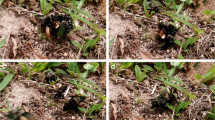Abstract
The mating behavior of adult Tropilaelaps clareae males and females was observed in glass test tubes. The male jumped on the dorsum of the female, stretched legs I forward, and hooked their distal ends on the frontal margin of the female dorsum. He then slipped sideways to the female venter. In the venter-to-venter position, the male clasped the female between her legs I and II, with his legs I. The male then moved backwards until his gnathosoma reached about 1/2 way along the epigynial plate of the female. The male vibrated and probably pushed the spermatophore out of his body. Next he moved laterally and placed the gnathosoma between coxae III and IV where the gonopore is located. Probably the sperm was introduced into the gonopore by means of the spermatodactyl. Subsequently the male moved to one side and stroked the anterior part of the epigynial plate and the gonopore area with his leg II. He repeated these contacts on average 282 times (variation 100 up to 522). The male then moved on the other side of the female venter and repeated the whole procedure. Finally, the male withdrew himself backwards from the female. The total mating process lasted between 3 and 42 min, with an average of 23 min. Multiple matings of both, males and females were observed.
Similar content being viewed by others
References
Alberti, G. and Hänel, H., 1986. Fine structure of the genital system in the bee parasite, Varroa jacobsoni (Gamasida: Dermanyssina) with remarks on spermiogenesis, spermatozoa and capacitation. Exp. Appl. Acarol. 2: 62–104.
Akimov, I.A. and Yastrebtsov, A.T., 1984. [Reproductive system of Varroa jacobsoni. I. Female reproductive system and oogenesis.] Vestn. Zool. (6): 61–68 (in Russian).
Akimov, I.A. and Yastrebtsov, A.T., 1985. [Reproductive system of Varroa jacobsoni. II. Male reproductive system and spermatogenesis.] Vestn. Zool. (2): 63–69 (in Russian).
Akimov, I.A., Starovir, I.S., Yastrebtsov, A.V. and Gorgol, V.T., 1988. [The Varroa mite-the causative agent of varroatosis in bees. A morphological outline]. Naukova Dumka, Kiev. 120 pp (in Russian).
Amano, H. and Chant, D.A., 1978. Mating behaviour and reproductive mechanisms of two species of predacious mites, Phytoseiulus persimilis, Athias-Henriot and Amblyseius andersoni (Chant) (Acarina: Phytoseiidae). Acarologia 20(2): 196–213.
Castognoli, M. and Liguori, M., 1991. Laboratory observations on duration of copulation and egg production of three phytoseiid species fed on pollen. The Acari: Reproduction, Development and Life-History Strategies. R., Schuster and P.W., Murphy (Eds) Chapman & Hall, London: 231–239.
Costa, M., 1966. Notes on macrochelids associated with manure and coprid beetles in Israel. I. Macrocheles robustulus (Berlese, 1904). Development and biology. Acarologia 8(4): 536–547.
Costa, M., 1967. Notes on macrochelids associated with manure and coprid beetles in Israel. II. Three new species of the Macrocheles pisentii complex, with notes on their biology. Acarologia 9(2): 319–326.
Donzé, G., 1993. Beobachtung von Varroa jacobsoni in Brutzellen. Landw. Jb. Schweiz (1/2): 282–287.
Dosse, G., 1959. Über den Kopulationsvorgang bei Raubmilben aus der Gattung Typhlodromus (Acar., Phytoseiidae). Pflanzenschutzberichte 22(8/9): 125–133.
Elbadry, E.A. and Elbenhawy, E.M., 1968. Studies on the mating behaviour of the predaceous mite Amblyseius gossipi (Acarina, Phytoseiidae). Entomophaga 13(2): 159–162.
Evans, G.O., 1992. Principles of Acarology, C.A.B. International, Wallingford. 563pp
Hänel, H., 1983. Histologische Untersuchungen zur Reproduktion von Varroa jacobsoni. Apidologie 14(4): 257–258.
Ifantidis, M. D. and Rosenkranz, P., 1988. Reproduktion der Bienenmilbe Varroa jacobsoni (Acarina: Varroidae) Entomol. Gener. 14(2): 111–122.
Jakeman, L. A. R., 1961. The internal anatomy of the spiny rat mite, Echinolaelaps echidninus (Berlese). J. Parasit. 47: 329–349.
Krantz, G.W. and Wernz, J.W., 1979. Sperm transfer in Glyptholapsis americana. In Rodriguez, JG (ed) Recent Advances in Acarology, Vol. 2. Academic Press, New York: 441–446.
Lee, D.C., 1974. Rhodacaridae (Acari: Mesostigmata) from near Adelaide, Australia III. Behaviour and Development. Acarologia, 16(1): 21–44.
Michael, A.D., 1892. On the variation of the internal anatomy of the gamasinae, especially in that of genital organs, and on their mode of coition. Trans. Linn. Soc. Lond. soc. ser. Zoology 5(9): 281–324 + 4 plates.
Oliver, J.H.Jr. and Krantz, G.W., 1963. Macrocheles rodriguezi, a new species of mite from Kansas (Acarina: Macrochelidae) with notes on its life cycle and behavior. Acarologia 5(4): 519–525.
Prasad, V., 1967. Biology of the predatory mite Phytoseiulus macropilis in Hawaii (Acarina: Phytoseiidae). Ann. ent. Soc. Am. 60(5): 905–908.
Rath, W., Delfinado-Baker, M. and Drescher, W., 1991. Observations on the mating behavior, sex ratio, phoresy and dispersal of Tropilaelaps clareae (Acari: Laelpidae). Int. J. Acarology 17(3): 201–208.
Wei, H.Z., 1992. Study on generative characteristics of Tropilaelaps clareae Delfinado et Baker (Acari: Laelapidae). Proc. XIX International Congress of Entomology, Abstracts XVIIP No 9: 675.
Woyke, J., 1987. Comparative population dynamics of Tropilaelaps clareae and Varroa jacobsoni mites in honeybees. J. Apic. Res. 26(3): 196–202.
Woyke, J., 1989. Changes in shape of Tropilaelaps clareae females and the onset of egg laying. J. Apic. Res. 28(4): 196–200.
Woyke, J., 1993a. New data from the biology of the parasitic bee mite Tropilaelaps clareae. Proceedings 2. Jenaer Bienenkundliches Symposium. Jena 26–28 März: 108–111.
Woyke, J. 1993b. Survival and reproduction of Tropilaelaps clareae. Proc. XXXIII International Congress of Apiculture, Beijing (in press).
Woyke, J., 1994a. Tropilaelaps clareae females can survive for four weeks when given open bee brood of Apis mellifera. J. Apic. Res. 33(1): 21–25.
Woyke, J., 1994b. Repeated egg laying by females of the parasitic honeybee mite Tropilaelaps clareae. Delfinado and Baker. Apidologie 25 (3):327–330.
Woyke, J., 1994c. Risque d'introduction en Europe de nouveaux acariens parasites des abeilles melliferes. La Santé de l'Abeilles. 141: 111–123.
Author information
Authors and Affiliations
Rights and permissions
About this article
Cite this article
Woyke, J. Mating behavior of the parasitic honeybee mite Tropilaelaps clareae . Exp Appl Acarol 18, 723–733 (1994). https://doi.org/10.1007/BF00051539
Accepted:
Issue Date:
DOI: https://doi.org/10.1007/BF00051539




